Landwards
The professional journal for the Institution of Agricultural Engineers
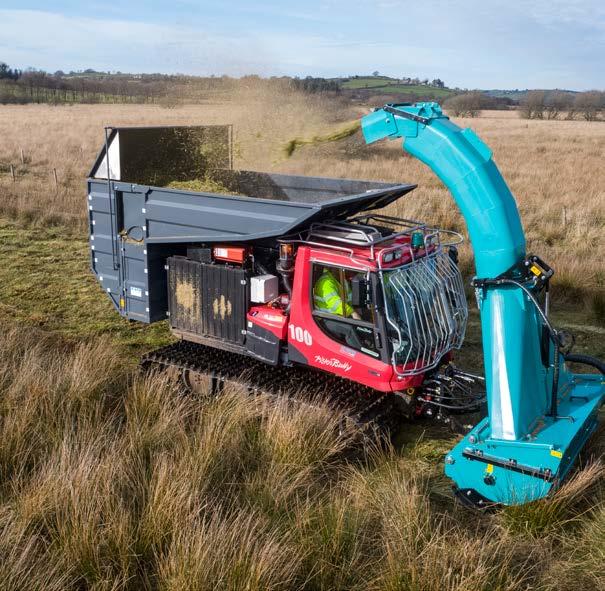
In this issue...
Practice – Water Management
People – Award Winning Engineers
Profession – Environmental Engineering
Technical – Peatlands and Net Zero



In this issue...
Practice – Water Management
People – Award Winning Engineers
Profession – Environmental Engineering
Technical – Peatlands and Net Zero


launched in partnership between the Institution of Agricultural Engineers (IAgrE) and the Society for the Environment is the new grade of Registered Environmental Practitioner (REnvP).
This is a huge step forward to ensure high standards of professionalism and proven competence are met by those working to enhance and protect the environment across every sector.
This registration is timely and relevant for agricultural engineering and the associated technology sectors and the intention is that professionals in the industry will apply. The industry includes many different disciplines which need people to apply a professional approach and the Registered Environmental Practitioner grade is ideal for this.
Why should I register?
• Improve your career and salary prospects
• Stand out from the field
• Join a network of dedicated professionals
• Demonstrate your competence and skills.
Register through IAgrE now:
t: +44 (0) 1234 750876
e: membership@iagre.org
w: www.iagre.org
Although the standards are high, IAgrE makes the process simple.
“The launch of REnvP is a landmark moment for environmental professionalism, providing more individuals with the opportunity to gain professional registration and achieve external verification of their competence.”
Dr Emma Wilcox Chief Executive Officer of the Society for the Environment




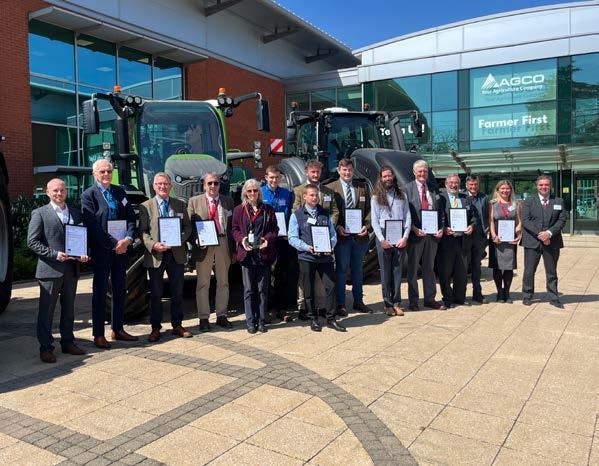
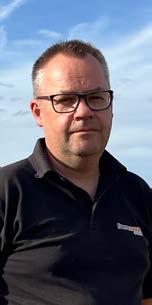
If you are an existing Associate Member you have the option to upgrade to Member grade providing you have completed 5 or more years in a relevant career. However, if you prefer, you can remain as an Associate Member for as long as you wish.
For more information scan this QR code or contact Alison at; membership@iagre.org
I realise that mentioning the weather, at any time, immediately precipitates a change in the prevailing conditions. In this case, I feel safe, given 14mm of rain since the start of April, followed by 120mm in the last week or so, all bases are covered.
Awards ceremonies are great occasions to acknowledge service and achievement, and it was a pleasure to attend the Institutions Awards day at AGCO’s Abbey Park HQ back in April. Well done to all recipients. See page 18 for more details.
The guided tour around AGCO’s training school was an insight into how an international manufacturer values and develops their service engineers, well worth a read from page 24.
Regarding dealer development, Alastair Tulloch reflects on how they will have to change to keep pace with new technologies in Opinion from page 30.
Another Alastair (Taylor this time)
considers how engineering in the environment complements agricultural engineering (and vice versa) in Profession p26.
The edition then moves on to have a look at a novel water management system designed to improve the sustainability and reliability of crops in East Anglia in Practice from p34.
Technical from page 38 looks at the part peatlands play in carbon sequestration and how engineering can influence this.
Having shied away from themed editions of Landwards from the outset, on reflection we could perhaps call this the ‘environment’ edition.
I hope you enjoy the read as much as I have enjoyed pulling this together.
Andy Newbold Hon FIAgrE ARAgS Editor andy@farm-smart.co.uk
JCB has passed another significant milestone on its pioneering hydrogen technology development programme after securing the first full EU type approval of its hydrogen engine for use in non-road mobile machinery.
This means that JCB’s hydrogen engine has been approved for sale and for use in machines and third-party OEM equipment in each of the 27 EU member states, and all other territories recognising EU type-approvals (e.g. EEA and EFTA territories).
The EU type-approval certificate has been issued in accordance with Regulation (EU) 2016/1628 and certifies JCB’s hydrogen combustion engine to prevailing EU Stage V emissions norms. The EU type-approval follows earlier landmark rulings by licensing authorities in nine countries in
mainland Europe allowing the engine to be used commercially in machines in those countries under ‘new technology’ provisions.
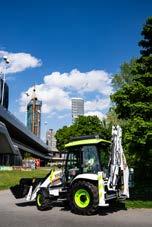
A new world record has been set at Birch Farm, North Yorkshire, where an AgXeed AgBot 5.115T2 tractor and Kverneland LO 300/85 five-furrow plough covered 51.8 acres autonomously in 24 hours.
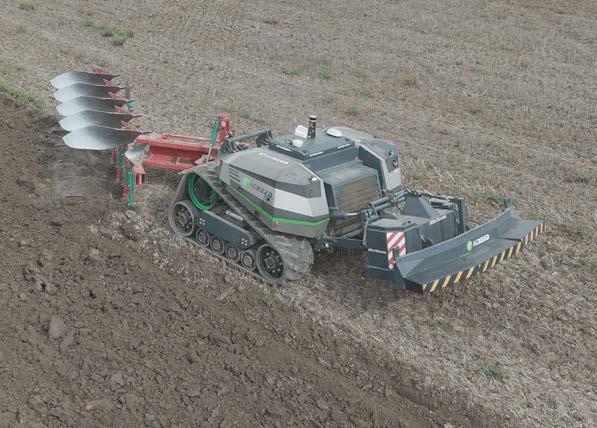
AgXeed and Kverneland have set a new world record at Birch Farm, North Yorkshire, where an AgXeed AgBot 5.115T2 tractor and Kverneland LO 300/85 five-furrow plough ploughed 51.8 acres autonomously in 24 hours.
Verified by James Whitty of the Society of Ploughmen, this achievement demonstrates autonomous fieldwork viability under real-world conditions.
The AgBot maintained 23 cm depth
and 40 cm furrow width, operating at 5.6–8 km/h with only one refuelling stop. Its fuel use averaged 18.4 L/ha, on par with conventional tractors.
Pre-trials showed the AgBot used 4.6% less fuel than a farm Fendt 828 Vario, due to its efficient driveline and lack of cab comfort energy demands.
Advanced planning software pre-mapped field boundaries and optimized working patterns. The AgBot autonomously lifted, reversed, and turned the plough, assisted by
GPS precision and remote monitoring.
The Kverneland plough’s low-draft body #28 mouldboards ensured quality ploughing even in heavy soils.
“This shows autonomous agriculture is now a practical reality,” said Peter Robinson, AgXeed.
This record signals a shift towards autonomous field operations as a scalable and efficient farming solution.
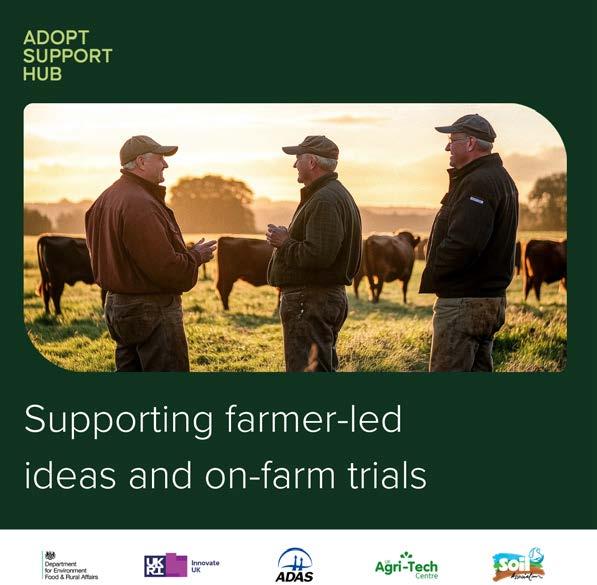
The UK’s land-based sectors are facing a critical challenge — how to adopt and embed cutting-edge innovation in real-world settings. In response, the UK Government has launched the ADOPT (Accelerating Development of Practices and Technologies) Fund, aiming to
bridge the gap between research and practice.
For agricultural engineers, this is more than just a funding stream — it’s a call to action for the land-based engineering community to lead the charge in practical innovation.
Managed through the UK Agri-Tech Centre, ADOPT supports farmer-led projects that trial and implement on-farm technologies or practices with the potential to benefit productivity, environmental sustainability, or animal health and welfare. What makes this fund
unique is its bottom-up model — farmers or growers in England must be the lead applicants, but they are encouraged to collaborate with specialists, engineers, and researchers who can bring technological and scientific rigour to the trials.
Agricultural engineers, data specialists, robotics developers, and land-based technologists all have a vital role to play in shaping and supporting these on-farm trials.
Whether it’s developing equipment adaptations for more efficient direct drilling, designing remote monitoring tools for livestock, or refining nutrient mapping sensors for horticulture, your expertise is critical to making innovation stick in the field — literally.
While the fund requires the lead applicant to be a farmer or grower
Drop a line to the UK Agri-Tech Centre using either of these emails
thomas.slattery@ ukagritechcentre.com
wallace.currie@ ukagritechcentre.com

UK Agri-Tech Centre would love to hear from engineers and innovators who are ready to bring practical impact to farming, growing and forestry.
in England, collaborators can come from across the UK. That opens the door for engineers, academics and consultants from Scotland, Wales and Northern Ireland to get involved in impactful cross-border innovation.
In practical terms, you might find yourself working with a Lincolnshire arable farmer to tweak a piece of kit for regenerative tillage, or advising a Worcestershire grower on adapting solar-powered automation systems — these are real opportunities to test theory in the dirt.
There’s also strong alignment between the ADOPT Fund’s ambitions and the engineering values that underpin agricultural engineering: measurable outcomes, systems thinking, resource optimisation, and above all, relevance to real-world application. It’s a chance to connect lab innovations and engineering
prototypes to the people and processes that need them most.
If you’re interested in supporting or joining a project, the ADOPT Support Hub can be found here. Please scan the QR code as your first port of call.
The hub helps match interested partners and provides essential guidance on eligibility, project scope, and timelines. It’s not just for those with something to test — it’s also for those with skills and solutions ready to apply.
Scientists in the Resilient Farming Futures science programme working on Rothamsted’s North Wyke Farm Platform in Devon, part of the UK’s National Bioscience Research Infrastructure, have found that even well-managed grazing and arable systems are struggling to withstand modern winter wet weather extremes, leading to dramatically increased sediment loss from fields into rivers.
Using over a decade of high-resolution (15-minute) environmental data collected at North Wyke (Britain’s most monitored farm), researchers assessed how rainfall during five recent winters—including three of the wettest on record—affected soil erosion and sediment loss; a key indicator of water quality regulation. They compared this against a baseline of “modern background” sediment loss rates based on pre-World War II levels identified using dated lake cores collected from across the UK.
The findings are stark. In pastures that had undergone routine ploughing and reseeding just before winter, sediment loss surged to as much as 2.4 times the expected modern background level. But in arable fields growing winter wheat and spring oats—losses were up to 21.7 times higher than the modern background rates.
These losses translate into significant environmental costs, with damage estimates ranging from £163 to £507 per hectare for permanent pasture and up to a staggering £2,812 per hectare for arable systems over the five winters studied.

As ever in the agricultural sector, we move swiftly from one challenge to the next. Currently, prolonged dry weather is creating difficulties across the UK. Grass growth is faltering, and crop development is under pressure. Here in Cheshire, we’ve had virtually no rainfall for weeks. While these dry conditions aid spring drilling, they hinder silaging and crop establishment. Even the ploughing matches I attended this season were disrupted; the final few felt more like ploughing concrete. Let’s hope rainfall returns soon to replenish our reservoirs and revive plant growth.
Spring also brings an opportunity to reflect on success. This year’s IAgrE Awards ceremony took place at AGCO’s Abbey Park facility in Stoneleigh. Full coverage is available on page 18. These awards celebrate individual and team achievements— ranging from student innovation to sector-wide contributions. If you’ve never attended, I strongly encourage you to do so. Better still, consider nominating a colleague or student.
Engineers tend not to seek the spotlight, but recognition is crucial for fostering talent and raising awareness of our profession. We receive many excellent student entries—though often from the same institutions. Broader participation from other colleges would make the competition even more rewarding and inclusive.
We’ve just completed a successful accreditation visit to Atlantic Technological University (ATU) in Galway, Ireland. ATU’s BEng (Hons) in Agricultural Engineering is producing high-quality graduates who are already employed at leading Irish manufacturers such as McHale, Abbey, and Malone. Their facilities are impressive, and students benefit from cross-disciplinary learning with mechanical, energy, and biomedical engineering cohorts.
IAgrE is licensed by the UK Engineering Council to accredit degree programmes. This ensures that qualifications meet the required educational and professional standards. Accreditation is a key part of our work, and we undergo review ourselves every five years. I’m pleased to report that our recent audit went extremely well. The Engineering Council’s rigorous process yielded commendations for good practice, as well as helpful feedback.
Thank you to Alison Chapman for leading our successful submission, and to Malcolm Carr-West and Steve Parkin for their support. We are now re-licensed to award professional titles—CEng, IEng, and EngTech— for another five years. If you’re considering professional registration, now is the ideal time to start.
Our Annual General Meeting was held online in May, continuing our commitment to accessibility. President Dr Mark Moore provided a thoughtful update on IAgrE’s strategic direction. We were also pleased to welcome two new Executive Committee members: Philip Pinn (Richard Western Trailers) and Dr Sarah Parsons (Harper Adams University).
Membership engagement remains strong. A warm welcome to our new members, and thanks to all who contribute through professional registration, committee work, and support of IAgrE activities.
A quick reminder—if you haven’t yet paid your subscription, consider setting up an annual Direct Debit to receive a £10 discount (£5 for Technician grade). Professional fees are also tax-deductible.
For any finance-related queries, please contact Jo at: finance@iagre.org
For more information about the IAgrE scan the QR code.
Charlie Nicklin, CEO, IAgrE ceo@iagre.org
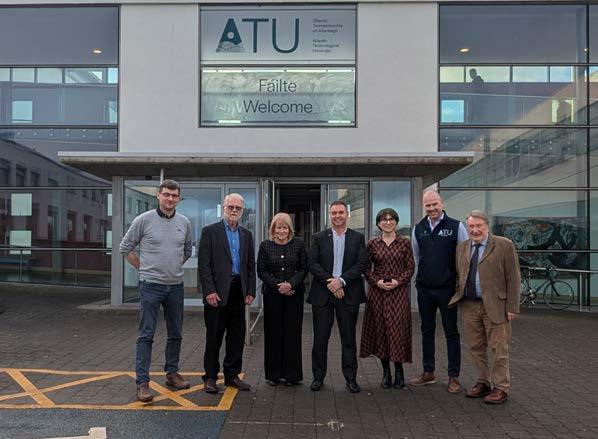
Atlantic Technological University (ATU).
Galway, Ireland
Scan the QR code to find out more about ATU and the courses they offer
ATU’s BEng (Hons) in Agricultural Engineering is producing high-quality graduates who are already employed at leading Irish manufacturers such as McHale, Abbey, and Malone.
Mark Moore
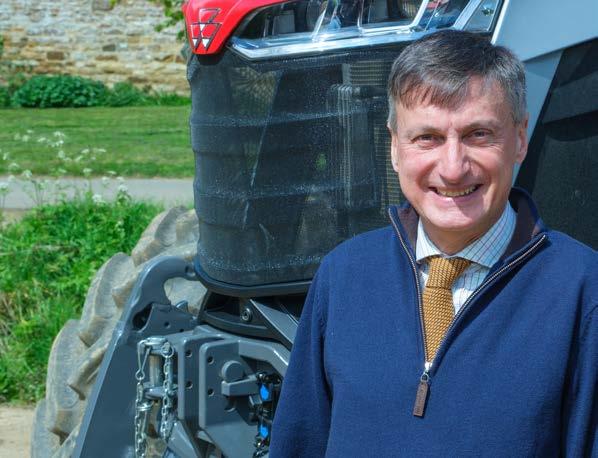
Artificial Intelligence (AI) continues to attract widespread attention, yet a clear, cohesive strategy for its application in farming and farm machinery remains elusive. Despite the noise, there is no doubt AI holds significant promise for transforming agriculture. By enabling smarter decision-making, reducing waste, and enhancing productivity, AI offers a path toward more efficient and sustainable food production—crucial as we strive to feed a growing global population.
NASA defines AI as “computer systems that can perform complex tasks normally done by human reasoning, decision-making, and creativity.” The Oxford English Dictionary echoes this, describing AI as the capacity of computers or machines to simulate intelligent behaviour. Crucially, AI systems are not merely following programmed instructions; they are capable of learning from data and improving their performance over time. However, it is important to remember that AI is not sentient. It
does not replicate human thought or creativity but instead excels at processing vast datasets to deliver pattern recognition, prediction, and decision support.
In agricultural contexts, some technologies promoted as AI-enabled systems are, in reality, advanced task automation tools. These systems, often relying on sensor inputs and pre-programmed responses, lack the adaptive, data-driven feedback mechanisms
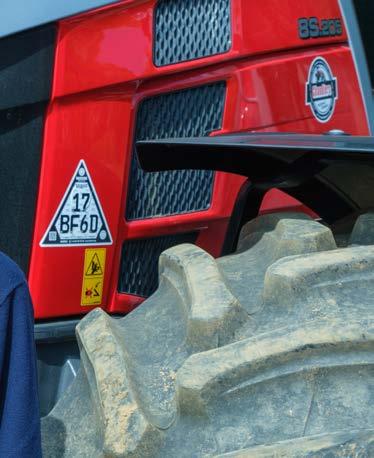
that define true AI. A good example is the Yara N-Sensor, which has been applying variable nitrogen rates for years—well before AI became a mainstream discussion.
Reflecting on my early research in the 1990s, I recall the challenges of interpreting yield data from the Massey Ferguson yield mapping system. Working alongside Simon Blackmore at Cranfield University, we developed an “Expert System” that used georeferenced data layers to identify trends and inform management decisions. At the time, tools like Surfer and ArcView on Windows 3.1 were groundbreaking, but we were limited by computing power and data access.
Fast forward more than three decades, and we still face a similar problem: vast amounts of farm data, but limited value extraction. Unlike mechanical systems, farming operates within an inherently variable and unpredictable biological framework. One year’s approach may not apply to the next. The question remains: how do we adapt management strategies dynamically in response to environmental variability?
The Promise of AI in Agricultural Decision-Making
AI could be the missing piece. By leveraging cloud infrastructure and machine learning, AI systems can
process complex, real-time data, identify context-specific insights, and suggest adaptive strategies for farm management. Unlike the expert systems of the past, modern AI can compare datasets across farms, regions, and seasons, making agriculture more responsive and precise.
The potential impact of AI on agricultural engineering is profound. It will require integration of disciplines—from data science and cloud computing to robotics and agronomy. Agricultural engineers are uniquely positioned at this intersection, translating abstract data into physical solutions on the ground.
To move forward, we need more than enthusiasm—we need clarity. What exactly do we mean by AI in agricultural engineering? What standards and outcomes should we expect from machine learning applications? And how can we ensure that these tools are accessible and valuable at the farm level?
I believe these are questions worth exploring together. AI is not a passing trend; it is a transformative technology that is here to stay. I propose that AI be the central theme of our IAgrE 2025 conference. This is an opportunity to lead the conversation, shape the narrative, and ensure agricultural engineers remain at the heart of this revolution.
I welcome your thoughts and look forward to engaging further with our members on this important topic.
Dr Mark Moore FIAgrE, IAgrE President 2024–2026
Biosystems Engineering
Volume 250, February 2025, Pages 117-132
Precision heating strategy based dynamic heater path planning for frost protection in apple orchards.
Weiyun Hua, Long He, Paul Heinemann and Minghui Zhu
Department of Agricultural and Biological Engineering, Fruit Research and Extension Centre, and School of Electrical Engineering and Computer Science, The Pennsylvania State University, University Park, State College, PA, USA
Highlights
• A precision heating strategy was proposed to prioritise high-demand tree canopies.
• Paths for multiple heaters working in multiple cycles were generated for frost protection.
• The improved algorithm had 36.8% and 98.7% less path cost and computational time.
• The precision heating strategy decreased the heater numbers up to 96.8%.
Frost is one of the severe weather events that causes economic losses in agriculture. Traditionally, heating can be applied in an orchard during a frost event either using fixed heaters or mobile heaters. In this study, a precision heating strategy is proposed to prioritise applying heat to orchard canopies with high heating demands utilising multiple mobile heaters. A precision heating experiment in a simulated orchard environment with dynamic multiple goal points was implemented with an improved A-Star path-planning algorithm. A path cost estimation method based on linear programming was presented to find the optimal paths for multiple heaters. In addition, a conflict-based search (CBS) method was integrated into the A-Star algorithm to make collision-free paths in an orchard to avoid static obstacles (trees) as well as and dynamic obstacles (other mobile heaters). An estimation method for the number of heaters required for a given heating strategy was proposed and the difference of
Biosystems Engineering, owned by the IAgrE, and the official scientific journal of EurAgEng, is published monthly with occasional special issues.
To view the full article list of the latest edition and to find out more about depth and breadth of articles accepted for publication scan the QR code.
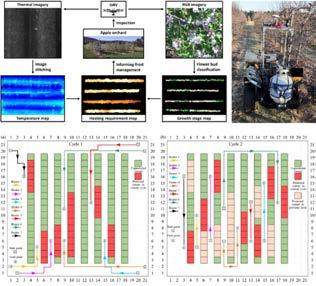
imagery can be used to identify areas where canopy temperature is approaching critical limits to frost damage (adapted from Yuan and Choi, 2021). Top Right: A mobile heating unit that can be deployed to avoid local frost damage (from Hua et al. 2024). Bottom: Example of path-planning solutions for an orchard with 7 available mobile heaters showing simulated cycles 1 (left) and 2 (right) for heater deployment to minimise travel/time and maximise frost protection (Red and Peach coloured areas).
the heater number between precision heating and traditional heating was compared. The simulated results showed that the improved A-Star algorithm was capable of generating no-collision paths for multiple heaters in multiple heating cycles, and had a higher search efficiency, shorter total path and required less computational time than the control group. The comparison between precision heating and traditional heating indicated that the number of heaters required in the precision heating strategy decreased significantly.
Overall, this study provided a concept of high heat-demand priority precision heating and proved its superiority for frost protection. The precision heating strategy had the capacity to protect canopies with less computational time
and fewer heaters. Nevertheless, the effectiveness of precision heating can be influenced by factors such as temperature monitoring, computational power, execution speed, and environmental factors. The proposed path planning algorithm may lead to suboptimal solutions due to the simplified problem of assigning a limited number of heaters to canopies. Future research can improve performance by identifying the pattern of cold spots through historical data on frost distribution and then incorporating additional constraints to replan routes in response to refined cold spot predictions. Overall, the study provided new insights into precision frost management and future work could be built upon these results to further investigate precision heating.
Reduced subscriptions are available to IAgrE members.
Scan the QR code for details of the preferential rates for both paper and electronic versions.
Biosystems Engineering
Volume 252, April 2025, Pages 105-114
Microcosm fabrication platform for live microscopy of plant-soil systems.
Y. Liu, D. Patko, A. de la Mata, X. Dong, E. Gomez Peral, X. He, B. Ameduri, V. Ladmiral, M. P. MacDonald and L. X. Dupuy
China Agricultural University, Ministry of Education Beijing, Ministry of Agriculture and Rural Affairs China, Beijing University of Technology, Beijing, China
North Dakota State University, Fargo, ND, USA
University of California, Davis, CA, USA Bangladesh Agricultural University, Mymensingh, Bangladesh
National Research Centre, Egypt
Highlights
• A microcosms fabrication platform for live microscopy of plant soil interactions.
• Microfabricated growth chambers enable control of growth and imaging conditions.
• New materials open avenues for the fabrication of artificial soils.
• Using this platform, the study revealed how roots improve water infiltration.
The ability to fully understand how plants acquire water and nutrients from the soil is constrained by the limitations of current technologies. Soil structures and properties are complex, dynamic, and profoundly modified by root and microbial secretions. Detailed descriptions of soil properties are rarely available to the researcher because natural soil is opaque, making direct observations challenging. To address these experimental difficulties, this study has explored ways to refine and streamline the preparation of soil microcosm systems designed for live, in situ imaging of root soil interactions.
This new approach involves the rapid prototyping and reproduction of chamber designs in a laboratory setting, employing techniques such as 3D printing, laser cutting, and cast moulding of parts. Intensive testing of the system
Over the past three months (February - April 2025), Biosystems Engineering published 51 articles, including 3 short communications. The following three articles have been chosen to illustrate the diversity of work published in the journal over the past three months.
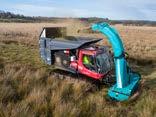
showed that the system can be tuned with regard to environmental conditions and the control of water content, enhancing the reproducibility and reliability of experiments. Furthermore, the exploration of various materials has identified several as being suitable for fabricating transparent soil substrates. Results demonstrated that the platform is suitable for a diverse range of experiments, including live observation of plant roots, split-soil systems and investigations into the effects of soil heterogeneity, controlled water content experiments, and dye tracer monitoring. The technique was used to quantify the increase in infiltration rate due to the
presence of roots in soil. This study demonstrates the potential of combining new materials and microfabrication techniques to create a microcosm system that can be used to effectively address current knowledge gaps in understanding plant-soil interactions.
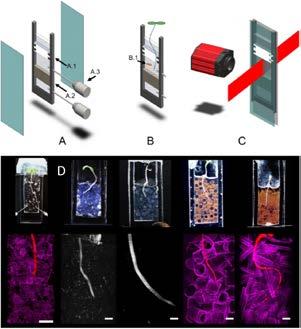
2. Top: Microcosm fabrication platform. (A) The chambers consist of two glass slides (blue, left and right) separated by a PDMS spacer (grey). (B) Microcosm chambers filled with transparent soils and soil microorganisms so that (C) observations of biological processes are possible through the glass slides, here using a light sheet microscope. Bottom: (D) Examples of live imaging of lettuce seedling grown in transparent soils made of five low refractive index materials
Biosystems Engineering
Volume 250, February 2025, Pages 306-316
The impact of temperature regulation measures on the thermodynamic characteristics of bee colonies based on finite element simulation.
Y. Lu, W. Hong, W. Wu, J. Zhang, S. Li, B. Xu, K. Wei and S. Liu
Agricultural Information Institute of Chinese Academy of Agricultural Sciences, Ministry of Agriculture and Rural Affairs, Beijing, China
Key Laboratory of Gravitation and Quantum Physics, PGMF and School of Physics, Huazhong University of Science and Technology, Wuhan, China College of Animal Science and Veterinary Medicine, Shandong Agricultural University, Tai’an, China
Defense Innovation Institute, Academy of Military Science, Beijing, China
Highlights
• Beehive thermodynamics were simulated using the finite element method.
• Ambient temperature changes significantly affect hive temperature and heat loss.
• Maintaining a larger colony size helps withstand extreme temperature variations.
• Use insulation with a thermal resistance exceeding 25 K W-1 to protect bees.
In recent years, the increasing frequency of extreme weather events and temperature fluctuations have posed significant threats to the survival of bee colonies. While artificial control of hive temperature can effectively protect bee colonies and conserve honey, there is a current lack of quantitative research on the effects of regulatory measures on colony temperature and heat loss. This study employed finite element simulation to model the thermodynamic changes in hives to simulate changes in internal temperature and heat loss in bee colonies under different scenarios. The findings indicated that the minimum heat loss in beehives occurred at an ambient temperature of 34°C. Variations in ambient temperature significantly affected the internal temperature and heat loss within the hive. An increase in colony size contributed to internal hive temperature control and enhanced

and the
2: Examples of temperature modelling of the entire hive (A) and the honeycomb area (B), and 3: Model validation by comparison of observed and simulated temperatures in different sections of the hives as ambient temperatures increase.
energy efficiency. However, the opening of ventilation ports at the top of the hive can lead to a several-fold increase in heat loss and should be used judiciously. Insulating the hive had the effect of resisting both high and low temperatures. It is recommended to use insulation materials with a thermal resistance value exceeding 25 K W-1 for optimal insulation effects.
The study analysed the impact of different control measures on the heat loss of bee colonies from the perspective of macroscopic thermodynamic balance, which can enhance our understanding of the relationship between beehive
temperature and energy consumption, and help to adopt appropriate temperature regulation measures to improve the survival ability of bee colonies in actual production. This study has important limitations, as it ignores the impact of individual bee metabolism and aggregation density on heat flow. It also assumes that the bee colony can maintain the temperature of the brood area at an ideal temperature, while the actual bee colony may have behaviours such as water collection and clustering in extreme high and low temperature environments, which may make the thermodynamic characteristics of the beehive more complex.
New map of soil health set to revolutionise how we manage soil in Europe and allow us to peer into the future
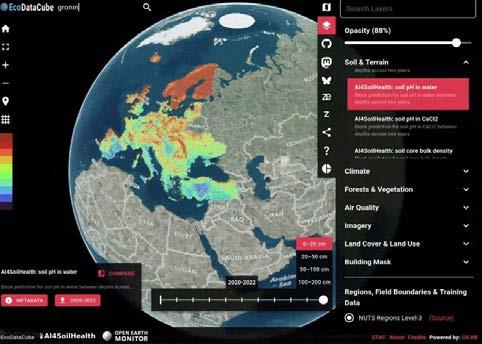
A new EU Soil Health Data Cube layered map will revolutionise how farmers, land managers and policy makers sustainably manage soil in Europe and enable us to peer into the future and model solutions for the worst impacts of climate change.
Almost one hundred scientists have contributed to the project, which integrates hundreds of thousands of observations and data points on soil, climate and vegetation using a multidimensional matrix powered by artificial intelligence and high performance computing. The Soil Health Data Cube currently spans from the year 2000 up to 2022 and is already 30TB in size. This new tool allows scientists and researchers to obtain open data representing European landscape and
soil properties in space and time, and can potentially be used to simulate complex scenarios and accurately predict, test and model real world solutions.
The Soil Health Data Cube Map enables users to monitor key soil health factors, including pH levels, soil carbon, and biological parameters over time with weather and climate data. Its spatial resolution is down to 20 or 30 metres with the addition of vegetation cover and most recently over 20 million European crop field boundaries. So, farmers will be able to access and view an accurate picture of the farms exploring historical and future patterns of soil health based on different climatic and land use scenarios.
This marks a significant milestone for the AI 4 Soil Health project team who are one of a group of Horizon Europe projects which fit under the EU’s and the Soil Health Mission for 2030.
AI 4 Soil Health is working with over 20 partner organizations to develop practical experiments on the ground to showcase regenerative practices to ensure good measurement tools are at the heart of soil recovery.
The AI 4 Soil Health partnership are confident that they will have a Soil Health app available in 2026 which will make this data available to all and allow farmers to benefit from this complex analysis on their mobile phone.
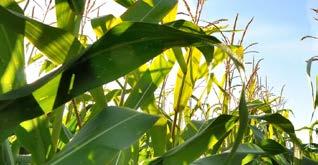
The 82nd International Conference on Agricultural Engineering LAND. TECHNIK will be held in Hannover on the 7th - 8th November 2025.
Time and time again the agricultural engineering industry and its research work has responded with innovative technical solutions and research findings to this mesh of seemingly contradictory, social, agricultural, technical, and ecological requirements and boundary conditions.
This edition’s topics include:
• Tractors, self-propelled agricultural machinery
• Power trains, electric drives and mobile hydraulics
• Agricultural information technologies, precision farming, software engineering, artificial intelligence and data handling
• Autonomous vehicles and machines
• Automation, robotics, electronic components and sensors
• Technologies of soil protection, tillage and sowing
• Harvesting technologies
• Sustainable energy for agricultural applications
• Industrial product development and market service
EurAgEng are partners of the LAND.TECHNIK AgEng2025 conference and all members are entitled to a discount on the full ticket price.
Find out more about EurAgEng

MOU agreed between the UK Agri-Tech Centre and
The Spanish National Research Council
The UK Agri-Tech Centre has announced the signing of a Memorandum of Understanding (MOU) with the Spanish National Research Council (CSIC), through its Institute of Natural Resources and Agrobiology of Salamanca (IRNASA-CSIC), which will help to advance agri-tech innovations and provides a framework for bilateral collaborations that address global agricultural challenges.
The MOU underscores the two organisations’ mutual dedication to promoting agri-tech development, facilitating collaboration and driving forward industry advancement.
Both the UK Agri-Tech Centre and the CSIC bring unique strengths to the collaboration projects, leveraging the UK’s expertise that includes precision agriculture, climatesmart technologies and animal health, alongside Spain’s innovations in agroforestry systems, sustainable inputs and renewable energy applications.

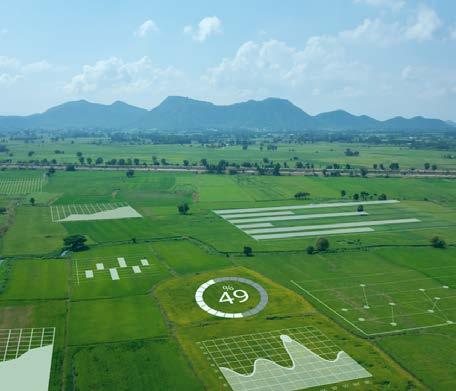
The 41st CIOSTA International Conference is set to convene from October 20–23, 2025, at the Daniel Hotel in Herzliya, Israel. Organised by the Agricultural Research Organisation – Volcani Institute, this biennial event will focus on “Agricultural Production and Management in the Era of AI, Robotics, and Advanced Technologies.”
CIOSTA 2025 aims to foster interdisciplinary collaboration among researchers, engineers, and industry professionals. The conference will feature oral and poster presentations, exhibitions, and networking opportunities, highlighting significant advances in agricultural engineering, production, and management. Key topics include automation, precision agriculture, AI-driven decision support systems, renewable energy, and sustainable farming practices.
Early registration is available until July 1st, with late registration commencing thereafter.
Chaired by Dr. Yael Salzer and Prof. Avital Bechar, CIOSTA 2025 offers a platform for professionals to exchange ideas and shape the future of agricultural technology. For more information and to register, visit the official conference website by scanning the QR code.
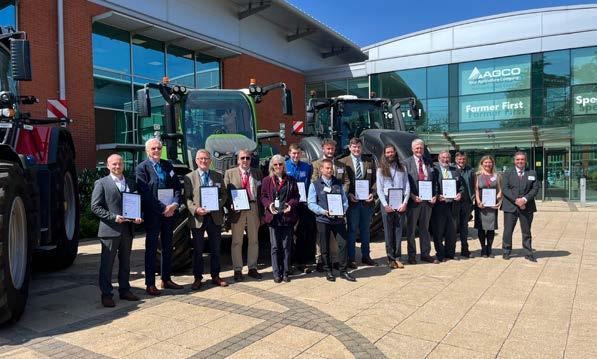
The 2025 award winners outside AGCO’s Abbey Park headquarters near Stoneleigh, Warwickshire
AGCO very kindly welcomed members and guests to their UK HQ at Abbey Park in Warwickshire to recognise and celebrate the achievements of members and significant others in agricultural engineering.
The Award is offered to the author or authors of a paper which, in the previous calendar year, was published in full in the institution journals “Landwards” and/or “Biosystems Engineering”. At least one of the authors must be a member of the institution.
The winners of the award this year, for their contribution to the paper were Albert Martin-Cirera, Magdalena Nowak, Tomas Norton, Ulrike Auer, and Maciej Oczak.
“Comparison of Transformers with LSTM for classification of the behavioural time budget in horses based on video data” Biosystems Engineering, Volume 242, 2024, Pages 154-168, ISSN 1537-5110,
Dr Tomas Norton FIAgrE Tomas said he and his team were honoured to receive this prestigious award from the Douglas Bomford Trust and IAgrE and he is always pleased to publish in Biosystems Engineering.

Dr Norton appeared via video to accept the award on behalf of the team.
Made on the basis of a dissertation or thesis undertaken by an undergraduate or postgraduate student as part of their studies demonstrating innovation and practical application in the land-based industry.
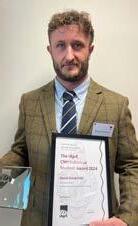
David Goodchild, EngTech TIAgrE
Harper Adams University
For his B.Eng dissertation; “Developing a standard tine wear evaluation methodology”.
Luke Waldram MEng, AMIAgrE
Harper Adams University
“An Investigation to Determine the Feasibility of Integrating Stop-Start Technology into Off-Highway Vehicles”. (Using a Mercedes Benz Unimog U530 as a case study)

This award is given to the best final-year project submitted as part of a course leading to ND, NVQ Level 3, or a similar qualification in land-based engineering.
Tom Ablitt, TIAgrE, Coleg SirGar
For his project; “Silage bunker cleaner”
This award has been established to encourage and recognise innovation in the safe design or operation of equipment or processes by students studying agricultural engineering or subjects related to the application of engineering and technology to the land-based sector.
Hywel Jones, TIAgrE, Coleg SirGar
For his project; “Trailed implement efficiency monitor”
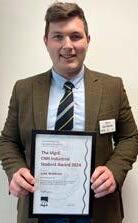
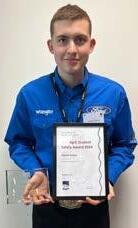
This award is made at the LAMMA Show to a new product that demonstrates the most positive contribution to the environment.
The 2025 Award was presented to Knight Farm Machinery for the Smart-Inject system for precision application of plant protection products at the LAMMA show in January by CEO Charlie Nicklin.
IAgrE member Brian Knight of Knight Farm Machinery was pleased to attend and accept the award.
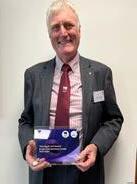
This Award is made to those who have made sustained contributions to the land-based sector throughout their career.
Ruth Bailey MIAgrE, Director General of the Agricultural Engineers Association. Ruth Bailey is a relatively new convert to the Agricultural Engineering industry having joined IAgrE a little over 10 years ago, at the same time as she took up the role of leading the Agricultural Engineers Association. As a straight-talking Yorkshire woman, she quickly built up a productive working relationship with the AEA members and partner organisations, such as IAgrE. Ruth is a loyal member attending council meetings and conferences and contributing to the long-term benefit of the industry.
Jeff Claydon, Claydon Yield-O-Meter Limited. Jeff Claydon has been farming his families land since 1970. Jeff invented the ‘Yield-O-Meter’ in 1980, he wanted a grain monitoring device that could be fitted to any combine that would provide the farmer with accurate information. It was a hugely successful invention, fitted many, mostly CLAAS combines, and earned a Royal Agricultural Society of England Silver Medal in 1995.
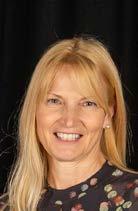
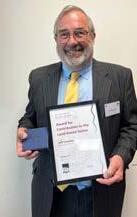
Made to members who have consistently rendered outstanding service to their Branch of the Institution or a Technical Group over a number of years.
Award made to David Yates EngTech MIAgrE for his support of the East Midlands Branch
When Richard Trevarthan stepped down after many years, no-one stepped in to take over. David organised an initial meeting and we formed a management group rather than the traditional branch structure. Each person takes responsibility for the meeting they propose, and David, with help from the Secretariat, coordinates and sends out reminders etc. It has worked well and we have had a number of well-attended meetings.
Again, this year we have no volunteers to take over, so David has agreed to do another year.
In addition to supporting the Branch and encouraging the younger members, hosting an evening at his business, he is active in many local shows and societies, including Southwell ploughing match and Hoveringham Show.
There was a real risk of the East Midlands Branch folding, and it lives on due to David and his hard work.
An award was also made to Chris Watts CEng CEnv FIAgrE (for his continuing support of and service to the Membership Committee.
Chris has been a member of the Membership Committee for 20 years and has contributed unstintingly to its work. Chris is both a Chartered Engineer and a Chartered Environmentalist, which means that he is able to participate fully in the full range of our registration activities.
He is active in conducting applicant mentoring, assessment and PRIs for both Engineering Council and the Society for the Environment registration. Chris is also a frequent member of our Accreditation Panels.
In all aspects of the Membership committee’s work Chris makes an invaluable contribution and has been key to IAgrE’s functioning as a professional body.
Chris is certainly worthy of the recognition that comes with an Institution Meritorious Award.
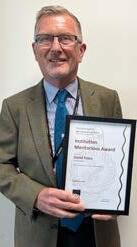

The prize is to a mid-career engineer who has made outstanding progress in the agricultural engineering industry. The Institution is delighted to make the award again this year:
Award made to Dr Paula Misiewicz AMIAgrE - for her achievements in agricultural engineering academic research.
Paula joined the Institution of Agricultural Engineers in 2010 serving as a member of both the Executive Committee and Council from 2012 to 2015. Paula presented an invited paper at the 2022 Landwards Conference entitled “Managing the Soil – the Science of Soil”. She is also an active member of the American Society of Agricultural and Biological Engineers (ASABE) serving as Secretary, Vice-Chair, and Chair of the Soil-Plant-Machine Dynamics Committee between 2019-2021. In 2023, she was co-recipient of the prestigious ASABE Distinguished Lecturer Award sponsored by Deere & Co., co-authoring a paper at the Agricultural Equipment Technology Conference in Fresno CA, USA in collaboration with colleagues from Iowa State University (USA) and CSIRO (Australia). She co-led the team that revised the ASABE Cone Penetrometer Standard.
Dr. Paula Misiewicz is an ideal candidate for the President’s Award. She is very active in her mid-career undertaking and leading topical soil management research, which is valuable for both UK and International agriculture. Paula is well respected internationally helping to maintain the UK’s reputation as a base for good science and engineering.

An award sponsored by the Douglas Bomford Trust for an individual who has made a substantial contribution to improving any aspect of the environment
Daniel Mitchell MSc HAU, for his thesis Investigation of the effects of compaction methods on the hydraulic conductivity of clay bunding to enable selective control of hydrology in agricultural and paludiculture applications
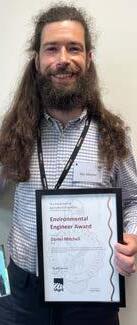
An award sponsored by the Douglas Bomford Trust for a team who have made a substantial contribution to improving any aspect of the environment.
Holme Fen Restoration Project lead by Martin Parsons CEng CEnv FIAgrE
Martin was joined by Jo Finlow from the project to receive this award.
Martin works for Natural England and the Fens East Peat Partnership, funded by the Nature for Climate Peatland Grant Scheme. This project is aiming to reduce GHG emissions from low-lying drained peatlands, where the emission can be up to 35-40 tonnes eCO₂ per hectare per year.
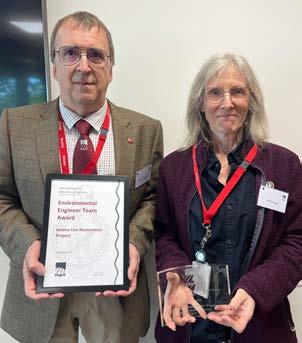
His work is focused mainly on Holme Fen NNR, a few miles south of Peterborough on the edge of the fens, where they are aiming to implement a drainage diversion scheme that will allow them to raise the water table within the NNR.
The Award of Merit is made to a person distinguished by their work in agricultural science or engineering or one that has rendered outstanding service to the Institution.
Professor Simon Pearson FIAgrE is widely recognised as the person who has brought robotics technologies to solve problems in the agricultural and horticultural sectors. He is currently the Head of School of Agri-Food technology and Manufacturing at the University of Lincoln – a school that was founded in August 2024 and based on three sites including The Lincoln Institute of Agri-Food Technology at the Riseholme Campus, the National Centre for Food Manufacturing in Holbeach and the Universities Seafood Processing Centre in Grimsby. Simon is now responsible for the school’s growth strategy and securing its financial resilience – a challenging role particularly at the present time.
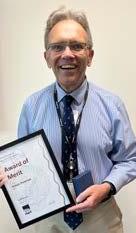
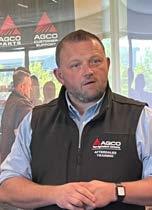
Richard Charles MIAgrE - Senior Manager of Aftersales Training Information and Content Development at AGCO
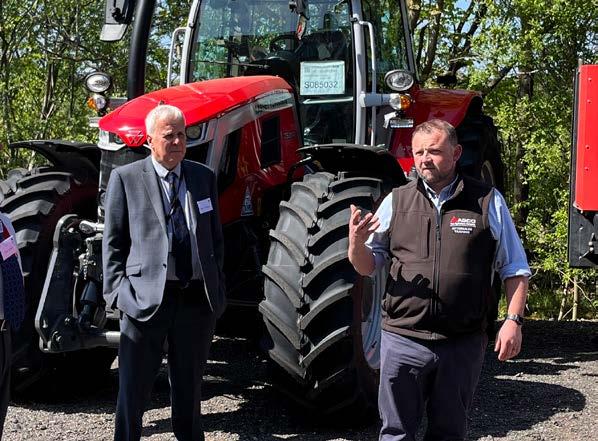
During the recent IAgrE awards event at Abbey Park, delegates had the opportunity to gain insight into AGCO’s comprehensive training framework, which plays a pivotal role in supporting the technical competence of the dealer network and enhancing the operational effectiveness of its agricultural machinery brands.
Richard Charles MIAgrE, Senior Manager of Aftersales Training Information and Content Development at AGCO, provided a detailed overview of the company’s
structured approach to workforce development. The visit also included a guided tour of the AGCO Academy training facility, a central component in delivering brand-specific technical education.
AGCO’s training strategy comprises two distinct tiers. Apprenticeships are delivered in partnership with a network of UK training providers— SRUC in Scotland, Moreton Morrell College, Coleg Cambria Llysfasi,
and Riseholme College—ensuring broad regional coverage. These programmes support approximately 220 apprentices across all year groups and are brand-agnostic, covering Fendt, Massey Ferguson, and Valtra.
The AGCO Academy at Abbey Park, by contrast, serves as a dedicated product training centre for dealer personnel. Hosting over 1,200 participants annually, the Academy provides hands-on, technical instruction across a broad range of topics and machinery systems.
AGCO’s training framework, plays a pivotal role in supporting the competence of the dealer network
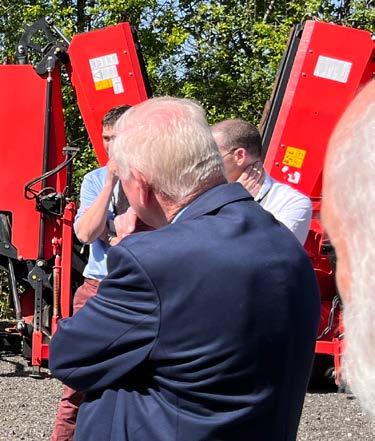
Course offerings include:
• Technical fundamentals of the tractor ranges
• CVT transmission and hydraulic systems
• IDEAL combine operation (fundamental and advanced levels)
• Electronic systems and diagnostics
• Air conditioning, refrigerant handling and product installation
• Walker combines and other key platform technologies
Centre of Excellence for Technical Skills
Located at AGCO’s Stoneleigh site, the Academy is a manufacturer-owned facility and serves as a central hub for developing technical competence across the AGCO dealer network in the UK and Ireland. The training
extends beyond apprentices to include service, parts, and sales personnel, with a strong emphasis on technical proficiency.
Courses are facilitated by in-house specialists and delivered in purpose-built training environments that replicate real-world servicing conditions. This structure ensures that technicians are well-prepared to maintain and support AGCO machinery to the highest standards.
Richard Charles also leads AGCO’s Global Content Development Team, which is responsible for designing technical training materials across all AGCO brands. The team comprises subject-matter experts embedded in key business units worldwide, including powertrain specialists from
AGCOPower in Finland.
Training content is developed to be interactive, immersive, and accessible in multiple languages— supporting AGCO’s global operations with consistent, high-quality instruction. This standardised, digital-first approach enables efficient knowledge transfer and reinforces AGCO’s commitment to lifelong learning and technical excellence.
AGCO’s continued investment in training infrastructure and curriculum development underscores the company’s recognition that well-trained personnel are essential to the performance and reliability of advanced agricultural systems. From complex combine diagnostics to precision electronics, the academy equips engineers and technicians with the critical skills needed to support modern, data-driven farming operations.
For agricultural engineers, AGCO’s model serves as a strong example of how manufacturer-led training can contribute to industry-wide capability, resilience, and innovation.
“Education is Not the Learning of Facts; It’s Rather the Training of the Mind to Think”. Albert Einstein
CEnv Alastair Taylor

Alastair Taylor IEng, CEnv, HonFIAgrE, former IAgrE CEO and the current Chief Licence Reviewer for the Society for the Environment (SocEnv) writes about how Agricultural Engineering touches the environment right across the wider discipline and how members should consider registration with the SocEnv as a way of showcasing their commitment.
I am writing this article as the Catholic Church elects a new pope so the term “All roads lead to Rome” is a rather appropriate title. In a lighter moment, the editor and I were discussing what white and black smoke means to us with the usual engineers analysis around worn injectors, a head gasket problem or worn piston rings. That set our minds thinking about the
environmental impact and how Agricultural Engineering touches the environment across most of its disciplines. Write me an article about professional registration for the environmental sector he asked, so here goes ….
Someone once asked me to define
what we mean by a “professional”. The easiest way to define this is to consider the opposite, namely an “amateur”.
• Would you want an amateur to complete your financial accounts?
• Would you want an amateur surveyor to value your land?
• Would you want to take your dog to an amateur vet?
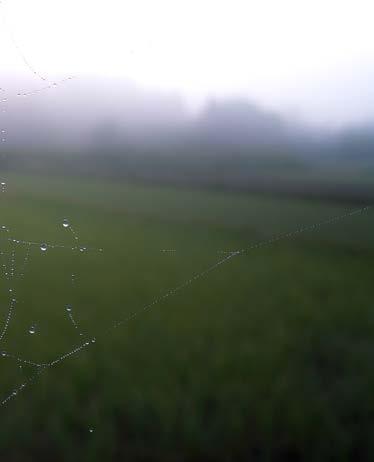
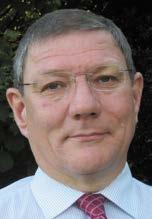
I really don’t think so! The point I was trying to make was that for all those services we usually look to a professional person. I rather hope that our farming community would want the very best professional engineer to service their expensive and valuable farm equipment although I think we have some way to go to reach that goal.
When it comes to the environment the Soc Env offers three levels of professional registration. There is Chartered Environmentalist, the Registered Environmental Practitioner and the Registered Environmental Technician. I myself am a Chartered Environmentalist and I am very proud of that level of recognition.
We all know that agricultural engineering is a discipline which cuts across many different subject areas. The environment features large in many of them. If we consider the work of those members who are working with soil, water and irrigation, it is clear that those subjects are rich in matters relating to the environment so for one of those professionals to become a Charted Environmentalist it would make perfect sense. Many of our members have taken that personal responsibility and have become registered as a way of demonstrating their skills and commitment.
If we consider our colleagues who work with sprayer technology and the like, clearly their work is to make most efficient use of the precious chemicals and to minimise the environmental impact so again they too could consider registration as a Chartered Environmentalist as a way of showcasing their professional approach to this important area of work.
The same goes for many other parts of our discipline. For example designing farm buildings with the environment close to the heart of thinking is important be that minimising energy usage, the control of runoff and pollution from animal wastes and all the other aspects which would have a negative impact on the environment.
Even those who are engaged in core manufacturing ought to be considering the impact of their work and how they can reduce it from an environmental perspective. Of course it makes good sense to produce things efficiently with as little waste as possible so sustainable practices make good business sense. Therefore it is relevant that people working in front line manufacturing could also consider environmental registration as a way of showing their contribution to making a positive impact.
At the recent IAgrE Awards ceremony I was struck by IAgrE member Martin Parsons who when I first met him worked for a major engine manufacturer dealing with exhaust emissions and reducing CO2. It was his work in that area which gave him sufficient evidence to gain Chartered Environmentalist registration. To my amazement I found that he had moved on to a completely different career working on the restoration of peat bogs in the Fenland area of England. That has to be Environmental Protection at its very best and brings home the concept that all roads lead to the same thing. Our discipline has environmental protection at the very heart and it is great to see people holding down such important job roles. Look at our members who work on catchment sensitive areas and the mitigation of run-off.
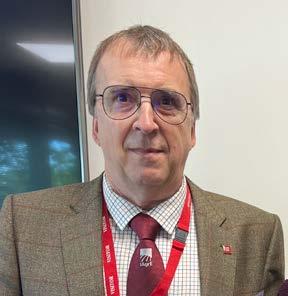
It was my great pleasure a few years back to mentor Alex Cooke who at the time was completing a PhD at Cranfield University and was one of the youngest people ever to gain Chartered Environmentalist registration. She now works as Head of Natural Capital at The Devonshire Group.

Read more about Alex and her fantastic journey by scanning the QR code
I would urge anyone working as an agricultural engineer to consider whether their work would allow them to become registered with the SocEnv in some way whether that is at technician, graduate or masters level there is something for everyone. The diversity of licenced bodies involved with the SocEnv encompass the broad range of subject specialisms and technical expertise where protecting the environment is at the heart of the job. Even if you don’t think you do this, I think I could persuade you that you probably do qualify to become a
“Modern agriculture must look in the mirror and consider how it is perceived.”

registered professional with the SocEnv.
In a world where there is more cynicism about climate change and reducing our carbon footprint, in my personal view the need to raise awareness and make a statement as to how our work improves the environment is increasingly important. It is essential if we are to change the minds of those sceptics who are cynical about climate change and its impact.
It makes me very sad when I see a picture on Social Media of a large tractor ploughing a field with belching black smoke and exaggerated wheel slip. Too many people (and especially our youngsters) don’t seem to have a clue as to how bad this is and on so many levels. Air pollution, carbon release, compaction and drainage problems, I could go on…. Suffice to say that modern agriculture must look in the mirror and consider how it is perceived.
So when the white smoke rose from the Sistine Chapel in Rome and a
new Pope was elected I was hopeful that he will be able to have a positive influence on all those people who follow him to make them think about their environmental impact and how we must do a better job if we are to protect society and the world from the negative impact of climate change and environmental bad practice. We really do need evangelists to continue to preach the message as much as they can.
Perhaps the SocEnv should invite him to be an Honorary Fellow. All roads really do lead to the environment and its protection.
Opinion
Dealership development


It seems agriculture is going through a period of significant change, particularly in the arable sectors and not for the better. With so many issues stacked against it, there is little confidence for the future and therefore little appetite for investment, at least from family farms. IAgrE member Alastair Tulloch MIAgrE reflects, whilst looking ahead.
There seems to have been a pattern developing for some time that the sons and daughters of family farms have not all favoured following in their parents footsteps, although most, understandably, elected for retaining the asset. Sadly, recent developments could well accelerate this decline in the traditional family farm.
One of the likely changes could be the increase in more corporate, business based agricultural enterprises, trying to achieve the economies of scale and more
efficiency of operation.
Such ‘agri-business’ type farms could be the ones seeking autonomy as a part of that drive for efficiency. If so, they will have a different approach as seen by these developments to date. A new machine is much less of an emotional purchase, and more of a business tool to do a job, so the interest is not so much in the features and benefits, but the cost of operation per hectare or
hour. Part of the requirement will be a guarantee of up-time and a commitment to get the job done in a timely manner.
For agricultural machinery producers and suppliers this might necessitate a revised approach, in that autonomous machines will be required to cover larger areas, which could influence their size to avoid the need for numerous smaller units. In any event, achievement of their function will be the key requirement. Part of the attraction is the perceived advantage of the autonomous

IAgrE
product not requiring a ‘driver’ and there is a possible inference that the farm manager would just need to set the machine in motion to follow a pre-determined programme. The question is will this be the practice or just the theory?
From the After Sales perspective of the machinery business, experience would suggest that newly developed autonomous machines are unlikely to be simply ‘plug-and-play’. In comparison with factory autonomy, agricultural machines will need to work in an adverse environment and at present have little in the way of past development experience to draw on. If there is a fault, the ‘manager’ will have little option or knowledge other than a simple re-boot. If that is not successful, who will be able to help and how quickly? The managers of larger corporate agri-business ventures do not tend to be machinery enthusiasts, and
their time is likely to be taken up with management of the whole business, which these days is very busy given all the current regulatory requirements in addition to the control of costs and crop production in unpredictable weather. All particularly relevant in an era of precision farming.
Could the machinery requirement be covered by the future local agricultural machinery dealer, in a similar way to the services utilised these days by agronomists? Could the machinery dealer become an all encompassing ‘services’ provider?
The dealer would need to present the best product for the specific circumstances, the best options for cost control and finance to offer a competitive operation per hectare or hour, which fits with the farm manager’s requirements. A suitable finance package would need to be
included as would a full service and maintenance package to guarantee up-time. The dealer could also offer an operation service, to effectively become the ‘driver’ of multiple machines in different locations for a number of farm businesses, all operating to the farm manager’s timing.
The bottom line as ever, would be the cost of operation, so how such products are supplied, financed and operated is then a part of the service provided on contract at an agreed cost per hectare basis.
Could it be made to work? There would probably be some enthusiasm for such an operation from business minded managers, who are more interested in financial results than ‘wonderful machines’ which are just there to do a job. The ‘wonderful machine’ is the concept of the agricultural engineer.
Such developments would obviously change the relationships between machinery manufacture, dealer and end user requirements. Dealer personnel would need to be fit for purpose, well trained and effective, bringing a new perspective to such an organisation. It could also encourage smart people from outside the traditional agricultural background experience.
It might also be necessary to encourage agriculture to become a 5 day per week function, as the pressures of a work life balance from the current and future generations will not want to work 75 hours per week. Even if autonomous machines could work 100+ hours per week in theory, they might still need to be monitored.
Perhaps this is a way in which the so called ‘new revolution’ of agriculture is initially realised in an autonomous world, designed to bring additional efficiency.
As a wise man once said: “If you want to be the leader, you have to keep running”.
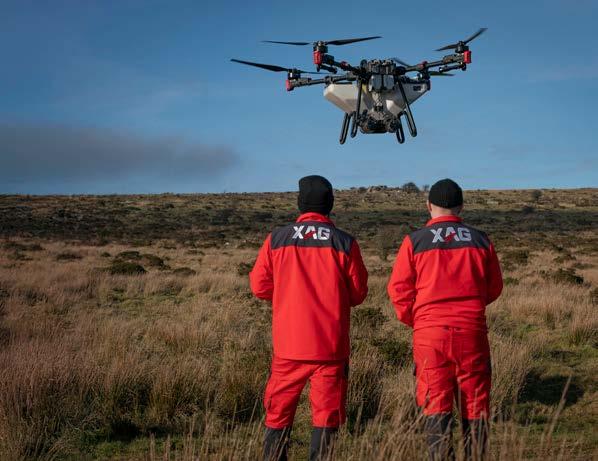
SEAD Artists is a consortium of like-minded drone experts supporting agricultural innovation using new technology and drones. The current participants are Autospray Systems, Skypointe, the University of Liverpool and DronePrep, and they are open to new members. SEAD Artists has collaborated on several projects utilising drones in specific settings, including Paludiculture and forestry.
Their work is now set to overcome the regulatory hurdles that have hampered drone use and adoption in the industry.
SEAD Artists believe the issue is building the evidence to demonstrate safe use. “It is the willpower to put your mind to it to make those applications, and that’s
what we are spearheading,” says Andy Sproson, COO of Autospray Systems.
“We’re the only people who have started to find solutions that satisfy the regulator,”.
“It’s the same with agricultural drone spraying. Yes, you can’t apply a product unless the application method is on the label, but there are processes in place.”
Aleks Kowalski, CEO of Skypointe, believes there are three main areas beyond visual line of sight (BVLOS) drone operations need to address. Put simply, these revolve around where the operator is, where everybody else is, and what the risk of people on the ground is.
“The only way people have been able to fly drones so far has been using visual line of sight (VLOS). Usually, this means you are restricted to flying the drone no more than a range of 500 metres from where you take off.
“This is very limiting if you want to fly over thousands of hectares.”
Now, BVLOS has become a reality. It involves categorising low altitude, below 15 metres in their case, as an atypical air environment with an improbable likelihood of a collision with a crewed aircraft. The CAA announced a policy concept for this late last year, says Aleks.
“We’ve taken this policy concept and made a safety argument to the regulator that the type of spraying
Andy does fits within that airspace at low altitude,” he adds.
This means that, presently, Autospray Systems is the only operator that can fly BVLOS without any trials or restrictions on the type of activity. Aleks believes they have unlocked BVLOS and are the first to do so in the UK.
To go with their new BVLOS capability, Andy has been working towards regulatory approval for drone spraying of key plant protection products.
“We’ve had to create drift data to quantify how far it goes if you spray it with a drone. Our drift is down to 15 metres, which is equivalent to a horizontal boom sprayer.”
They already have trial permits for some products. Slug pellets were announced last year, which could be a game-changer for farmers struggling through a wet autumn.
“We also have a biological insecticide called Dipel, which we’ve used to treat box caterpillars and oak processionary moths in oak trees. Other products are coming down the line. We have 13-15 at the end of the application process with the HSE (Health and Safety Executive).”
Andy adds that this includes an application for glyphosate products, which would put drone spraying on many farmers’ radar. “We are hopeful that we will have our glyphosate active substance-based product approval very shortly.
“This season, our operators will be in the field applying these products on a trial basis, but with the benefit that we will be controlling the pest or weed while they gather data to support further commercial approvals.”
SEAD Artists will speak at an Agri-TechE online event “Unlocking the potential of drones” on July 14th .
For more information scan the QR code
Ask any farmer tackling black grass on their farm, and they will say June is the month when the success or failure of their weed control strategy becomes apparent. For the worst fields, they must also decide whether to take it to harvest or spray it off and stop the seed return for future crops.
Many farmers will also spot spray patches of black grass in a field. With BVLOS and aerial application approval, this is where drones now offer a speedy and cost-effective solution.
“I was speaking to a farmer who spent nine hours driving 28 kilometres through their crops’ tramlines in their sprayer to treat under a hectare of blackgrass dotted through the wheat crop.
“We’d have done that in 20 minutes,” says Andy.
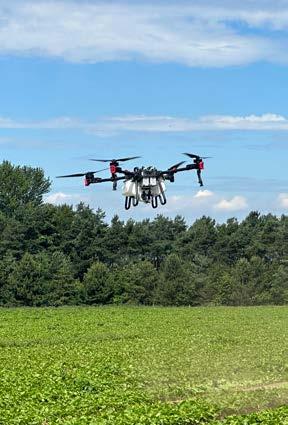
Felixstowe Hydrocycle
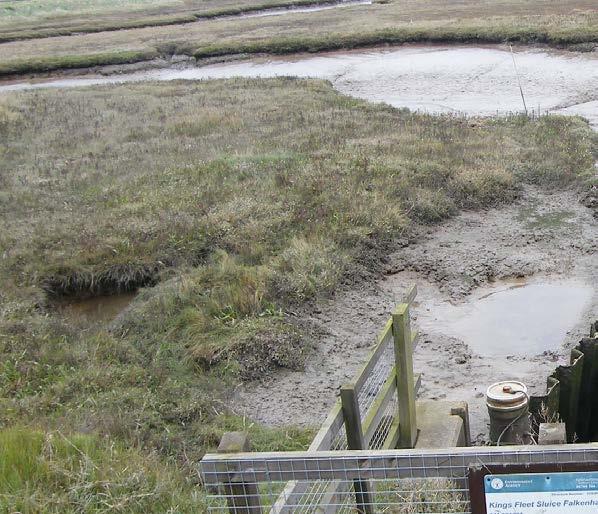
One group of East Anglian growers have got together to ensure future water supplies. Jonathan Wheeler reports on the results.
Managing water supplies in an era when climate change is affecting both the volume and seasonality of rainfall is a growing concern for farmers all over the world.
And it is a special problem for farmers in East Anglia, a region that receives the lowest rainfall in the country.
But a group of farmers on the Felixstowe Peninsula in Suffolk now benefit from an innovative water re-cycling scheme that could be replicated in other similarly water-deficient regions.
Sustainable sourcing
Felixstowe Hydrocycle Limited is a farmer-led water supply and
management company developed in collaboration with the Environment Agency, the local authority and drainage board to provide sustainably sourced water for farmers on the peninsula.
It is necessary because there is not enough water available on the peninsula for any to be abstracted for agricultural use.
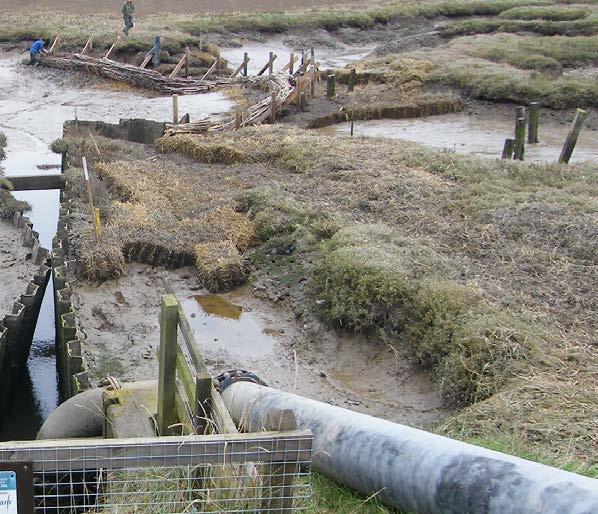
River mouth water abstraction reduces the risk of erosion whilst avoiding flow reductions.
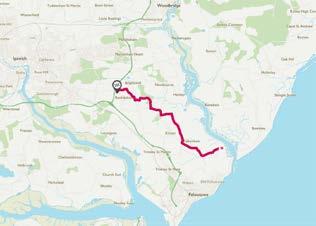
Felixstowe Hydrocycle uses a 14 - kilometre pipeline to take water from the Kingsfleet, at the mouth of the River Deben, and return it inland.
The water is a combination of urban run-off and land drainage water from agricultural land, which accumulates in the Kingsfleet.
Taking it from this location rather than each farmer abstracting it from the river avoids reducing flows and also reduces the risk of eroding sensitive mudflats and saltmarsh.
The pipe feeds reservoirs and lagoons on the farms of the company’s six farmer members.
It runs through the farms of another five non-member farmers, with whom easement agreements have been agreed.
The company behind Felixstowe Hydrocycle was formed in 2018 and the pipeline built in 2021, and financed by the farmers and a major grant from the EU.
It achieves two very valuable roles, helping farmers on some of the country’s most productive soils maintain efficient production, while also protecting several highly sensitive and water dependent environmental features.
Without it farmer Will Jolly believes cropping and business prospects on his 600 acres at Brightwell, would be very different, and he joined the company from the start.
The farm’s soils are mainly sandy types ideal for growing a vegetablebased rotation that currently includes potatoes, onions, carrots, lettuce, spinach, cabbages and sugar beet, as well as spring barley.
To irrigate those crops he has a 140,000 cubic metre capacity reservoir, which used to be filled from the Mill River under an aggregated abstraction license.
However growing domestic and industrial demand (which includes that need for the building and running of the Sizewell B nuclear power station) combined with uncertainty over future supplies meant he felt he could not rely on that for the long term.
“We have a licence to abstract from the Mill River but I felt
that was not very secure.
“How much we could take depended on availability. After a really dry summer there was a danger we might not be allowed to take anything the next winter”.
He suggests that in three of the past five years he might not have been able to obtain enough water to irrigate crops if they didn’t subscribe to the Hydrocycle.
The reservoir is filled over the winter, and can be topped up during the summer if there is enough water available.
“Without it we would face significant issues with which crops we could grow. We might have to switch away from the current regime, which would undermine the profitability of the business and even the value of the land”.
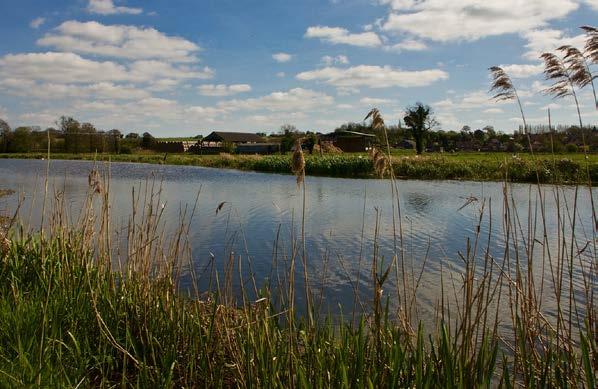
As well as recharging members’ reservoirs, the project has also staged a trial of Managed Aquifer Recharge (MAR), with some success.
Managed Aquifer Recharge is a technique that pumps water to surface ditches and lagoons, or into perforated pipes under the soil, from where it can infiltrate the ground and replenish groundwater reserves.
It is already used at a few locations in the UK, but is far more common in mainland Europe where the right geological conditions are far more widespread, says Professor Kevin Hiscock, from the University of East Anglia.
For it to work the aquifer needs to be able to absorb water and then release it quickly enough, he says:
“It only works in an aquifer like the Crag in Suffolk, where the soils are typically sandy and gravelly types, as it is on the peninsula, and in significant areas of Europe”.
The deepest area of the Crag aquifer in the Mill River catchment is around Bucklesham, which is where the trial was completed.
The Hydrocycle team worked with the Environment Agency to design a system that would provide irrigation water for farmers without affecting water levels in neighbouring rivers and ponds.
Under current legislation the Environment Agency could only allow water to be recharged to the aquifer if the quality was as good as that which was already there.
“In this instance we had to ensure it was below 165mg/litre of chloride, which fortunately the water from Kingsfleet is. In terms of nitrate content, it is actually better quality than that already in the aquifer”, says Kevin.
“In this trial we showed that it is possible to recharge an aquifer using this method, and do it efficiently from both environmental and financial standpoints”.
The project included laying 600 metres of perforated pipes under one field, with a “header main” of 225mm diameter feeding a network of four 125mm diameter pipes that fan out across the field:
“We got the water into the aquifer and raised the water table by some 30cms during the period of the trial. “But it was slower than needed when pumping out, so we had to install a second borehole to improve the flow rate so it was suitable for irrigation”.
Any water that is not extracted will stay in the aquifer and complement existing supplies.
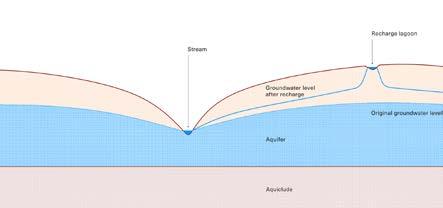
Technical
Harper
Paludiculture
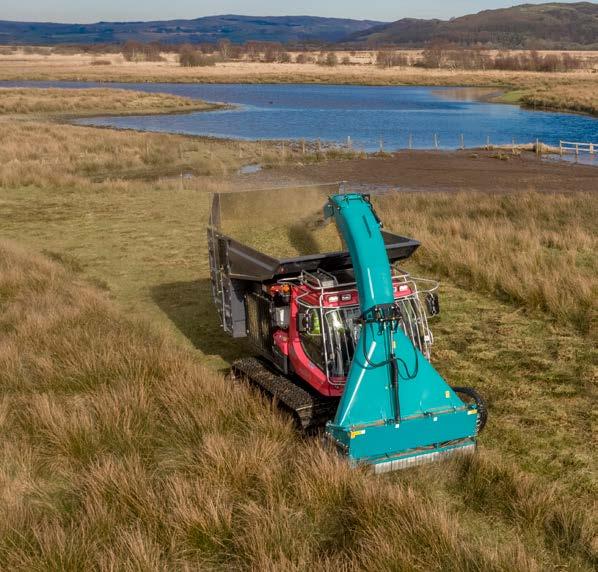
Peatlands, covering just 3% of the UK’s land area, are among the most carbon-rich ecosystems on Earth. In their natural state, they act as vital carbon sinks, storing over 600 gigatons of carbon globally—more than all the world’s forests combined.
Peatlands, cover just 3% of the UK’s land area
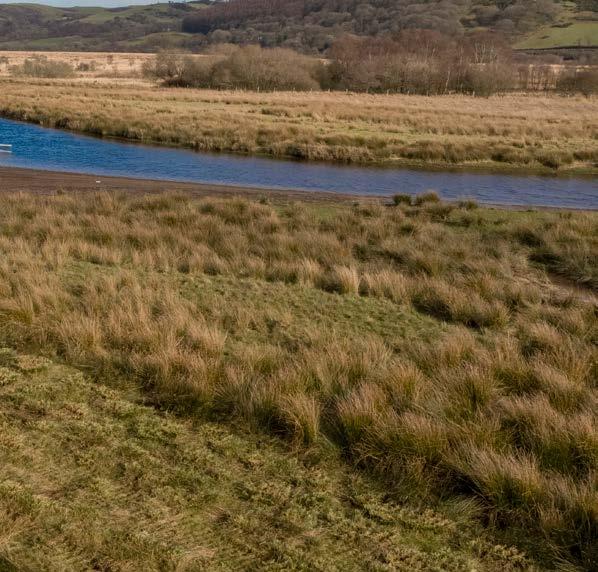
However, when drained for agriculture, these peatlands become significant sources of greenhouse gas (GHG) emissions. In the UK, emissions from agricultural peatlands contribute approximately 1% of the nation’s total GHG emissions.
As the UK strives to achieve net-zero emissions by 2050, restoring and sustainably managing peatlands presents a practical and impactful opportunity for farmers.
Historically, peatlands have been drained to create arable land, particularly in lowland areas. This drainage exposes the organic matter in peat to air, leading to its decomposition and the release of CO₂. Drained peatlands used for agriculture are among the most intensive sources of GHG emissions
in the land-use sector.
Rewetting these peatlands can significantly reduce emissions. By raising the water table, the decomposition of organic matter slows, decreasing CO₂ emissions. However, rewetting can also lead to increased methane emissions, a potent but shorter-lived GHG. Despite this, the net effect over time is a reduction in overall GHG emissions.
Rewetting involves restoring the natural water levels of peatlands. This can be achieved by blocking drainage ditches and implementing water retention structures.
Rewetting not only reduces CO₂ emissions but also restores the land’s natural functions, such as water purification and flood mitigation.
2. Paludiculture: Farming on Wet Peatlands
Paludiculture refers to the cultivation of crops on wet or rewetted peatlands. This practice allows for continued agricultural use of the land while maintaining high water tables. Suitable crops include reeds, sphagnum moss, and certain berries. These crops can be used for bioenergy, horticulture, and
other products, providing economic returns while preserving the peatland’s ecological functions.
Farmers can integrate sustainable practices such as reduced tillage, cover cropping, and organic amendments to enhance soil health and carbon sequestration. These practices, combined with peatland restoration, can contribute to the overall goal of net-zero emissions.
The UK government recognizes the importance of peatland restoration in achieving climate goals. Initiatives like the Lowland Agricultural Peat Task Force have been established to develop strategies for sustainable peatland management. Additionally, funding opportunities are available
to support farmers in transitioning to sustainable practices.
Peatlands offer a significant opportunity for UK farmers to contribute to the nation’s net-zero targets. By adopting practices such as rewetting and paludiculture, farmers can reduce GHG emissions, enhance biodiversity, and maintain productive land use. With appropriate support and incentives, the agricultural sector can play a pivotal role in climate change mitigation while ensuring economic viability.
Note: For detailed guidance and support, farmers are encouraged to consult with local agricultural advisors and explore government-funded programs dedicated to sustainable land management.
Harper Adams University has embarked on a pioneering initiative to become the UK’s first dedicated centre for the study of peat farming, focusing on sustainable practices that balance agricultural productivity with environmental conservation.
In 2023, Harper Adams University launched the Paludiculture Innovation Project (PIP), supported by the UK Government’s £5 million Paludiculture Exploration Fund. This initiative aims to explore paludiculture—the practice of cultivating crops on wet or rewetted peatlands—as a sustainable alternative to traditional farming on drained peat soils. The project seeks to reduce greenhouse gas emissions and preserve peat soils while maintaining agricultural productivity.
The university’s Future Farm at Adney Yard serves as a living laboratory where researchers are trialling paludiculture methods. By rewetting peat fields and cultivating appropriate crops, the project assesses the impacts on soil health, carbon emissions, and biodiversity. This hands-on approach provides valuable insights into the feasibility and benefits of paludiculture in the UK context.
Harper Adams University collaborates with various stakeholders, including farmers, environmental organizations, and academic institutions, to advance the understanding and implementation of sustainable peat farming. Events such as the Paludiculture Symposium facilitate the exchange of knowledge and experiences, fostering a community dedicated to innovative agricultural practices.
Through projects like the Patchy Peat Solutions initiative, the university examines the complexities of managing lowland peatlands. This research highlights the need for policies that support sustainable land use while considering the economic realities of farming. By integrating scientific research with practical farming knowledge, Harper Adams aims to inform policy decisions that promote both environmental stewardship and agricultural viability.
Agricultural engineering plays a vital role in advancing peatland management and the development of paludiculture—farming on wet or rewetted peat soils. Traditional drainage-based agriculture accelerates peat degradation and releases large volumes of greenhouse gases. Agricultural engineers are helping reverse this by designing systems that enable productive land use while
maintaining high water tables to preserve peat integrity.
Key contributions include developing precision water management infrastructure, such as adjustable weirs, bunds, and sub-surface irrigation systems, which help control soil moisture levels critical for peat preservation. Engineers also adapt or invent machinery suited to wetter conditions—for example, lightweight, low-compaction vehicles and specialist harvesters that can operate on soft, saturated ground without damaging the peat layer.
engineers support the cultivation and harvesting of wetland-adapted crops like reeds, cattails, and sphagnum moss. They also help integrate anaerobic digestion or biomass processing facilities to add value to paludiculture products.
By applying technology and innovation, agricultural engineering enables practical, scalable solutions that align environmental conservation with economic viability. This makes it central to developing sustainable farming systems on peatlands that reduce emissions, retain biodiversity, and support rural livelihoods.
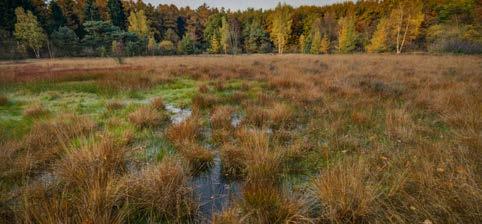
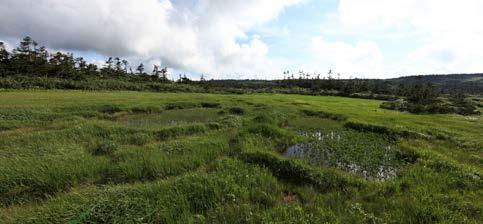

Firstly, a warm welcome to Chris Keeping, who joined the Douglas Bomford Trust in May as the new DBT Financial and Administration Officer and is “really excited by the challenge ahead”. Chris is replacing Elizabeth Stephens, who is retiring –a full report in the next edition.
Chris is a graduate of Newcastle University, where she followed her interest in sustainable agriculture by reading Agricultural and Environmental Science.
A qualified Chartered Accountant (FCA), Chris qualified with PricewaterhouseCoopers and worked for a number of years at Ernst and Young. Her subsequent career has been across a wide variety of organisations and sectors. Previous charitable experience
includes positions at a hospice and a community foundation.
Chris lives with her family on a smallholding in north Oxfordshire. Her hobbies and interests include horses; breeding, training and picking up with her labradors; developing her flock of rare breed sheep and gardening (Chris has a second degree in garden design from Sparsholt College). She also enjoys rowing and hill walking, recently completing the West Highland Way and is a keen supporter of Gloucester Rugby club.
The Douglas Bomford Trust provided a travel award for 10 Harper Adams University (HAU) Engineering Society students for a trip to Munich,
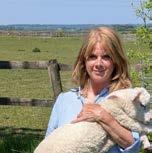
Welcome to Chris Keeping the new DBT Financial and Administration Officer.
Germany, from 9-13th April 2025. The aim of this trip was to aid the professional development of HAU engineers.
On the first day, the students visited Horsch GmbH, a family-owned global company designing and
manufacturing tillage, seeding and plant protection equipment. Michael Horsch gave an insightful and engaging talk covering numerous aspects of the business, including Horsch’s approach to product development and the growth of the company from Michael’s home farm. Max Plappert, one of Horsch’s product specialists, then gave a full tour of the manufacturing and research facilities.
The rest of the trip was spent at Bauma, the World’s leading Trade Fair for construction machinery and vehicles, and mining machinery, including live demonstrations. Caterpillar demonstrated a virtual cab for an excavator removing the operator from any dangerous situation.
The trip allowed students the chance to travel to another country, experience different cultures and environments. Also to engage in professional real-world engineering, and meet with engineers from all over the world and see how engineering concepts vary between countries.
“My favourite part about Bauma was meeting new people who I would have never met, networking at the show and seeing what’s coming in the future/what’s here now, and helping us to be ahead with our studies.”
“On behalf of all attendees, Society members, and the wider university, we would like to express our sincere gratitude for the Trust’s exceptional support for this trip”.
On 7th May, Nick August (DBT Chair) and David White attended the Harper Adams University Scholarship Presentation event. Douglas Bomford Trust Scholarships were awarded to engineering students Alexander Fuller-Shapcott, Eric Murray, Robert Siebert, Joshua Weaver, and Thomas Morgan. Congratulations. Great ambassadors for the profession.
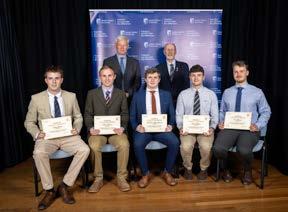
For further information, see the Trusts website:
Or contact the Secretary David White via: enquiries@dbt.org.uk
You can also follow: @BomfordTrust on ‘X’ and ‘LinkedIn’, for news , opportunities and events
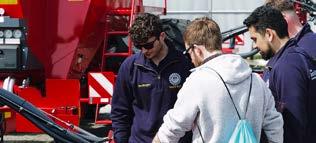
The Trust sponsored three of the awards made at the IAgrE Awards Presentation Day (see page 18 for the full rundown). All very worthy winners. Congratulations.
Branch meeting
Michelin Tyres
Report by Terence Chambers
The recent NI Branch meeting featured a presentation by Mr Chris Eakin, Michelin Territory Business Manager for Ireland, regarding Michelin’s “Beyond Road” tyre ranges. These include agricultural tyres and those used in other industry sectors like construction, quarrying and materials handling.
When Mr Eakin was growing up his family ran the business of “Eakins of Omagh” which was then a Fordson tractor dealership in Northern Ireland, He studied at Harper Adams from 1989 to 1992 and went on to join Michelin, as part of its Agricultural Team in Ireland, from 1999.
Since then the Michelin brand has acquired several other familiar names including BF Goodrich, Taurus and Kleber who had made the first radial tractor tyres.
The design of agricultural tractor tyres has progressed with the development of very flexible wall and tread designs. These are now capable of high traction and flotation at very low inflation pressures in the field as well as faster road travel speeds at higher pressures with full loads. Mr Eakin described the satisfaction expressed by customers, working in wetland areas of the field performance of very flexible low-pressure tyres and their comparative “almost walking on water sensation” when in use. This is now reflected in the wide range of sizes and pressures being used for field work. Many tyre sizes were quoted for specific working examples across the UK and Ireland.
The most recent availability of the option of Central Tyre Control Inflation Systems (CTIS) can now maximise tyre performance by providing on-the-move in cab control
and monitoring of selected different pressures for both field and road use. This normally uses the tractor air brakes compressor to restore the higher pressures.
After Mr Eakin had shared his technical knowledge and experience across the subject in such an informative, informal and enjoyable manner our new branch chairman Peter Verhoeven passed on sincere thanks to him from us all. This is a brief summary of the meeting , the full report is available on the IAgrE website
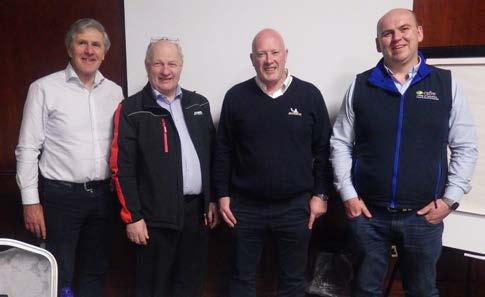
Report by David R White (Wrekin Branch) and William Waddilove (Chair, Pioneering Technology SIG)
In September 24 the IAgrE Pioneering Technology Special Interest Group (SIG) joined the Midlands Mill Group (MMG) on their autumn guided tours of three water mills.
The site is one of the last water-powered forge mills remaining in an intact state in the UK. Now very rural, the area was once an industrial area with over 10 mills within a radius of 1 mile of Churchill. Before it ceased operating as a commercial enterprise in 1969, the main items produced by the mill were forks, shovels, spades, hoes, rakes, coal shovels, firewood choppers and shovels for the salt industry. The mill is now owned by the Churchill Forge Trust Ltd and run by volunteers.
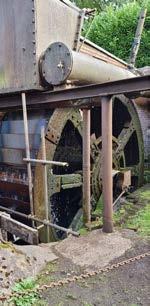
This is a working water mill originally used for milling flour. The mill has the largest cast iron water wheel in England with a diameter of 11.6 metres (38 feet). Our host, Mr George, whose family had owned the mill for over 250 years, gave a very comprehensive tour of both the inside and outside of the mill, and the associated surrounding area including the leat. The other Guide was Adam Marriott a Trustee and Millwright and had been instrumental in the wheel repairs following the catastrophic floods some years ago. The mill has hardly been altered since the 1700s. It is now run by a Charitable Trust

After an excellent lunch at The Witch on the Water café located next to the mill, the group of approximately 30 attendees made their way to The National Trust property, Knowles Mill.
A fascinating small water mill along Dowles Brook and the only one remaining in any shape of the ten or so along this valley in the middle of Wye Valley County Park.
Whilst not everyone wished to drive along the exceedingly rough track to the mill, those who wanted to eventually got there. We knew that some were dropping out as they had a long way to go.
The mill is owned by the National Trust although they are not regular visitors. Most of the structure is there and could be restored.
The waterway is still in reasonable shape although dry. The wheel has lost all its woodwork and some of the wheel side frames are broken but could be used for patterns during restoration. Pit wheel, wallower and crown wheel and stone nut are all there in enough shape to give a good idea.
The hosts were Tom Elliott (MMG) and Chris Bradley who lives in the adjacent Mill Cottage.
The day was very informative as well as being a social event. And we had good weather.
Sorry. Due to an oversight this report should have appeared in the previous edition of Landwards.
Marton Museum of Rural Bygones
Report by William Waddilove
The museum is a small village museum based around the collection of George Tims. He collected items from the area and also those items that were being thrown out as ‘modernisation’ swept through the country following the war. Once his house was full he moved to some of the stables belonging to the Rectory and then into some farm buildings.
Then some developers wanted to buy the farm. In settlement, they agreed to build a sports pavilion and the museum building.
In the best tradition of visits we started with a simple buffet and then a presentation by David Fry.
George died several years ago and the family handed the collection over to a village trust.
The museum is arranged in sections each with a theme.
Understandably most of our group were studying the farming related areas.
Certainly advice was offered on the repair of gearing on the grain cleaner and also the repair of chain on the recently donated chain of a Wolsley hand shearer. We think it may have an American standard chain and not a UK standard one!
It was a good turnout of members, with a few from a retired engineers group that I belong to.
Certainly from the questions and the time visitors were taking around the museum they found it interesting.
On a personal note, I do have some volunteer involvement with the museum; It is good to see how interesting people find it.
I think someone had the idea that if we can get that shearing machine fully functioning, we can then shear some sheep. I am hoping that the trustees realize it is the wrong end of
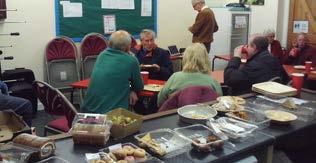
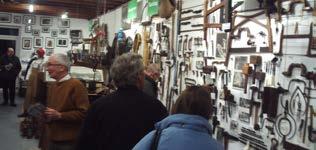
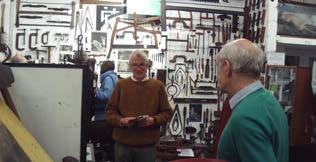
the year for sheep shearing and if they are expecting me to do the shearing, sorry no, I grew out of that many years (decades) ago!
I might get involved in some of the repair work as I am one of the few volunteers connected with the museum with engineering expertise and knowledge.
It is chastening to realise that I have stooked sheaves of corn and forked
hay, whereas most visitors have not even seen wheat before it becomes bread.
Sorry. Due to an oversight this report should have appeared in the previous edition of Landwards.
Crocodiles, conflict and silt. Experiences of irrigation across Asia
Report by Mike Whiting
With no previous farming experience, Chris Brown enrolled at Newcastle Upon Tyne University for a degree in Agricultural Engineering. This qualification provides a strong platform for many careers, and Chris’s CV certainly demonstrates this. He overcame the recession of the early 1980’s and secured employment with the Halcrow Group in the Hydrology section. This consultancy was one of the UK’s largest firms specialising in design and management services for infrastructure services worldwide.
The terms of engagement were for ‘training under agreement’ which would ultimately lead to chartership. Chris referred to an initial project requiring a full design specification, including calculations for a diversion weir. A quick internet search classes these constructions as the most important part of irrigation projects in developing countries.
The first passport stamp for Chris, and his partner Gillie, was to Bangladesh in 1986 with Sir M MacDonald and Partners who were renowned for their work in irrigation and water supply and became a career long employer for Chris. Food shortages after Bangladesh’s war of liberation in 1971 required special actions to avoid famine. The country has a natural geographical challenge, often referred to as a Delta. In laypersons terms, flat land. The resultant annual average water flow along the River
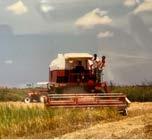
Ganges is around 45,000 cubic metres per second and the lack of roads and bridges in a densely populated yet impoverished country stifled economic development. Chris’s role as Field Officer required a simple but recognised process of creating and maintaining embankments to enable transportation of people and goods to markets and reduce the effects of flooding on agricultural production. Yet, as we’re aware water finds a way through temporary constructions, coupled with further erosion caused by ox-cart wheels which were addressed by a routine maintenance programme providing employment for destitute women. In summary, a challenging introduction to overseas work in terms of both professional and domestic lifestyle.
Their next postings in 1989 relocated Chris & Gillie to the drier region of Somalia. The irrigation project was focused on increasing rice production and included the construction of a mill to process harvested produce. Funding was provided by a $60M US grant facilitated by the German KfW bank who specialise in sustainable development initiatives.
The scope of works required the creation of a canal system fed from the Juba River to supply 77, two-hectare laser levelled flood irrigation blocks and additional sprinkler irrigation areas. Chris was responsible as Engineering Manager to bring the project into peak agricultural production. Such large volumes of water movement result inevitably in silt deposits which require constant attention. The presence of wildlife remained a constant factor resulting in hippos and crocodiles making their way into night storage reservoirs. The

recreational water sports undertaken by engineers in these lagoons was consequently brought to an abrupt halt. Despite all challenges, the project was successful producing rice and other crops with Chris’s slide including a photo of a modern cabbed Laverda combine harvesting rice. Ultimately providing a much-needed, if short lived boost to local food production before civil war halted operations.
We’re aware of the political instability in these fragile states and these projects often involved working in a high-risk environment for which special training was needed. This is highlighted by an image of Chris (on a visit to Afghanistan) with protective body and headwear often associated with a BBC news presenters reporting from the front line of hostilities.
Activities in 1990 moved up a level, literally, with the duo moving to Java in Indonesia. Here the irrigation systems were more complex requiring supply of water to rice production in mountain locations. The aim of the project was to increase food production by double cropping rice and adding a third dry season crop of vegetables, maximising use of available resources. Gillie took this opportunity to gain an MPhil in Water Management which launched her career in the social, economic and organisational aspects of irrigation.
Chris’s varied and informative presentation concluded with reference to the support provided in Asia after the 2004 Tsunami and rehabilitation following the Nepal earthquake in 2015. Both had resulted in thousands of deaths and the devastation to essential infrastructure for which urgent reconstruction by local government and local communities was encouraged. Other experiences included re-establishment and maintaining canal water levels and tree replanting on a pilot basis in Indonesia to reduce the release of carbon dioxide from deforested and exposed peatlands.
A huge thanks to Chris and Gillie for sharing the stories with us, confirming that agricultural engineers must exploit all their skills and creativity when solving problems.
01/02/25 to 30/04/25
Member
Mr Mike Herrington (Yorkshire)
Mr Pasco Warner (East Anglia)
Mr Jonathan Gill (Wrekin)
Mr James Simpson (Scottish)
Mr Kristof Hayes (South Eastern)
Affiliate
Mr Colin Pearson (Western)
Technician
Mr Dale Howard (East Midlands)
Mr Owen Black (Scottish)
Mr Michael Bontoft (East Midlands)
Mr Simon Barry (Herts & Essex)
Fellow
Dr David Purdy (East Midlands)
Member
Mr Adam Fryer (East Midlands)
Mr John Morgan (Wrekin)
Mr Andrew Court (Wrekin)
Associate Member
Mr Tom Edwards (S.Western)
Mr Luke Waldram (Wrekin)
We have recently learned of the death of the following members and we send our condolences to their family and friends:
Mr William H Mackenzie MIAgrE
Mr Mackenzie joined the Institution in October 1958 as an Associate Member and then went on to transfer to Member grade in January 1969. He gained his Incorporated Engineer registration through IAgrE in April 1973. Mr Mackenzie was a long-standing valued member of the Institution with over 65 years in membership.
Mr Anthony R Key MIAgrE
Mr Key joined the Institution in April 1969 as a student member. He then went on to transfer to Member grade in January 1974. Mr Key was a long-standing valued member of the Institution with over 55 years in membership.
Mr John A C Weir IEng CEnv HonFIAgrE
Mr Weir joined the Institution in November 1959 as an Associate Member. In March 1964 he gained his Incorporated Engineer registration through IAgrE and in January 1969 he transferred to Member grade. In January 1992 he went on to gain Fellow grade and in January 2005 he gained his Chartered Environmentalist registration with IAgrE. In May 2007, Mr Weir was awarded Honorary Fellow by the Institution. He was a long-standing valued member of the Institution with over 65 years in membership.
Mr John P Neat CEng FIAgrE
Mr Neat joined the Institution in October 1973 as an Associate Member. He went on to transfer to Member grade in December 1980 and then went on to gain Fellow grade in October 1984. He gained his Chartered Engineer registration with IAgrE in September 1985. Mr Neat was a long-standing valued member of the Institution with over 50 years in membership.
Mr Lance H Rayner MIAgrE
Mr Rayner joined the Institution in September 1977 at Member grade. He was a long-standing valued member of the Institution with nearly 50 years in membership.
Eur Ing Roger M Hay HonFIAgrE
Mr Hay joined the Institution in September 1985 as a Fellow and was then awarded Honorary Fellow membership in May 2000. He was a long-standing valued member of the Institution with nearly 40 years in membership.
Mr John Morgan (Wrekin)
Mr Tom Edwards (S.Western)
Brian
David W
Geoffrey W Burgess
Charles
15 - 17/07/2025 @ Case New Holland Tractors, Essex, SS14 3AD
03/09/2025 - All day
Smiths at Gretna Green, Dumfries & Galloway, Scotland, DG16 5EA

Wood, Water & Innovation:
Building Resilience in Rural Environments - join the IAgrE Forestry Engineering Group and their expert speakers as they discuss how resilience needs to be built in to all aspects of forestry, from bridges to flooding.
Booking is open at a cost of £100 + VAT per delegate and we look forward to welcoming you to what promises to be a fascinating Symposium.
The full programme is here.

The programme will involve Product technical updating and development which will include the Methane Tractors, Combines & Balers, Viticulture Machinery range and a tour of the manufacturing facilities and the Experience Centre.
This event will provide subject specific staff development for lecturers and others involved in training and education in land based (agricultural) mechanisation and engineering and those attending will receive a certificate to count towards their annual Continuous Professional Development .
More information may be found by scanning the QR code.
01/07/2025 - All Day @ Great Fen
We are delighted that Martin Parsons CEng CEnv FIAgrE, Peat Restoration Officer at the Natural England & Fens East Peat Partnership has offered to host a visit to the Great Fen on Tuesday 1st July.
Location
There are no facilities at all at Holme Fen, so Great Fen partners the Wildlife Trust BCN have kindly agreed to host the event at nearby Corney’s Barn, which is about a mile east from Holme Village railway crossing on the B660.
Agenda
• Arrive and coffee at Corney’s Barn (10:00 for 10:30am)
• Introductions
• Brief presentations on the Great Fen and restoration work –Introduction to the Great Fen Project, & restoration work at Holme Fen, New Decoy & Speechly’s Farm
• Site visit to New Decoy
• Lunch at Corney’s Barn, then (using as few vehicles as possible):
• Site visit to Holme Fen posts and Holme Lode Farm / Trundlemere Hide
• Return to Corney’s Barn / Depart
As you can see it should be a fascinating day, there are a limited number of places so please book early if you are interested in joining us. Scan the QR code
15/07/2025 - 1pm-2pm Online via Zoom
Stephanie Berkeley (Manager of the Farm Safety Foundation, Yellow Wellies and organiser of Farm Safety Week) will introduce the themes for Farm Safety Week (21-25 July 2025) and provide some background on the topics and activities that will support the Week.
This is an opportunity for IAgrE members to see how they can contribute - as individuals and within their businesses and organisations.






























































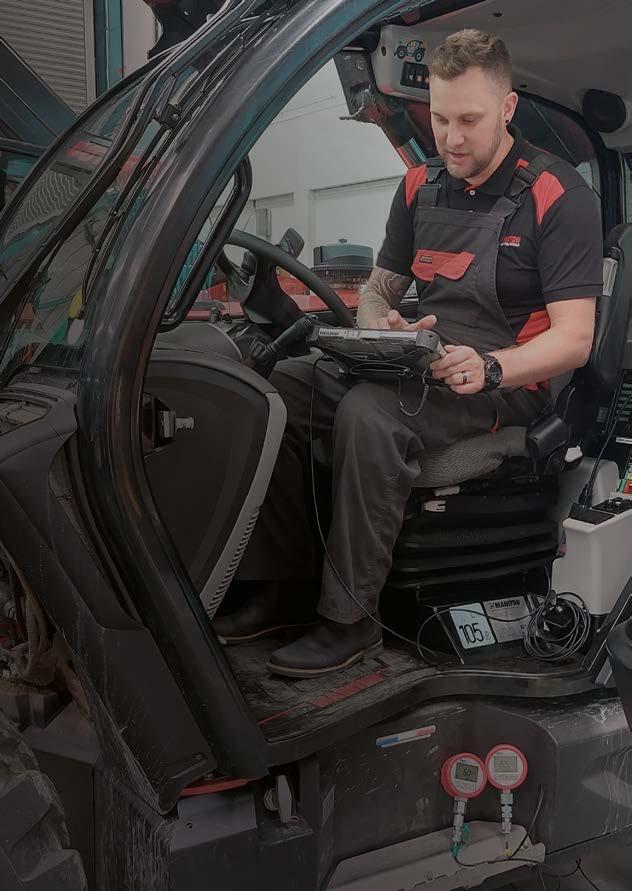
Technical presentations
eNewsletters
Access to Landwards journal
Networking opportunities
Competitions & awards
Local branches
Careers guidance & Jobs and much more
A listed technician with the Institution of Agricultural Engineers demonstrates a high quality of education and training, compliance to our code of professional ethics and commitment to continual learning. In addition to displaying your professional identity, you get lots of other benefits, as above. simply complete the online application form Visit iagre org for details